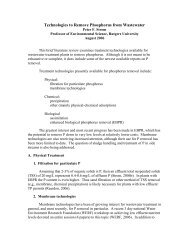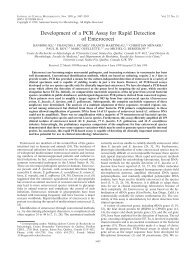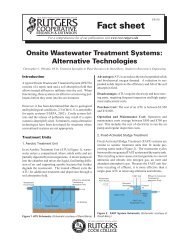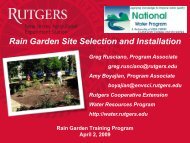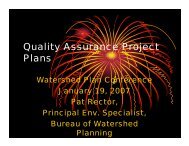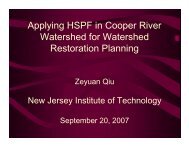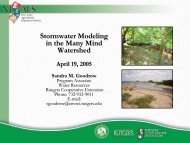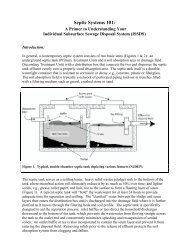Molecular Approach to Identify Source of Fecal Contamination EPA ...
Molecular Approach to Identify Source of Fecal Contamination EPA ...
Molecular Approach to Identify Source of Fecal Contamination EPA ...
You also want an ePaper? Increase the reach of your titles
YUMPU automatically turns print PDFs into web optimized ePapers that Google loves.
The Application <strong>of</strong> a DNA-based<br />
<strong>Molecular</strong> <strong>Approach</strong> <strong>to</strong> <strong>Identify</strong><br />
<strong>Source</strong>s <strong>of</strong> <strong>Fecal</strong> <strong>Contamination</strong>: The<br />
Search for Pathogens<br />
<strong>EPA</strong> Science Forum 2004<br />
Bonita C. Johnson, Microbiologist<br />
U.S. <strong>EPA</strong>, Region 4, Ecological Assessment Branch
Objectives<br />
• Provide a brief introduction <strong>to</strong> the use <strong>of</strong><br />
microbiological indica<strong>to</strong>rs <strong>to</strong> assess water<br />
quality.<br />
• Explain the significance and purpose <strong>of</strong><br />
using a DNA-based approach <strong>to</strong> identify<br />
probable sources <strong>of</strong> fecal contamination.<br />
• Provide an overview <strong>of</strong> the PCR<br />
(Polymerase Chain Reaction and Agarose<br />
Gel Electrophoresis method and<br />
technique.
Why are we interested in these guys<br />
• Pathogens are known <strong>to</strong> cause harmful<br />
(even deadly) infectious diseases.<br />
• Of the designated uses listed in section 303c<br />
<strong>of</strong> the Clean Water Act, protection from<br />
pathogenic contamination is most important<br />
for waters designated for recreation, public<br />
water supplies, aquifer protection; and<br />
protection and propagation <strong>of</strong> fish, shellfish,<br />
and wildlife.
Have committed violations associated<br />
with the following:<br />
• Safe Drinking Water<br />
Act<br />
• Total Coliform Rule<br />
• Surface Water<br />
Treatment Rule<br />
• Clean Water Act<br />
• Beach Act 2000<br />
• Total Maximum<br />
Daily Load (TMDL)<br />
• Ground Water Rule<br />
• Confined Animal<br />
Feed Operations<br />
(CAFOs)<br />
• Water Quality<br />
Standards
Known Hang-outs<br />
Primary <strong>Source</strong>s:<br />
Agricultural operations -<br />
lives<strong>to</strong>ck, manure<br />
Septic tank systems<br />
Drinking Water<br />
Systems<br />
Wastewater Treatment<br />
Systems<br />
Recreational waters-<br />
streams, lakes, ponds
Rap Sheet: Outbreaks <strong>of</strong> Disease<br />
• 1909 England<br />
• 1921 Connecticut<br />
• 1932 New York<br />
• 1942 California<br />
• 1947 England<br />
• 1958 Australia<br />
• 1973 Vermont<br />
• 1974 France<br />
• 1974 South Carolina<br />
• 1976 Iowa<br />
• 1982 Michigan
Modus Operandi (MO)<br />
Usually enter surface and groundwater by means <strong>of</strong>:<br />
• Flood events – s<strong>to</strong>rm water run-<strong>of</strong>f.<br />
• Abandoned wells - provide a direct channel for<br />
contaminants <strong>to</strong> pollute the aquifer below.<br />
• Poorly constructed wells - allow for contamination<br />
from septic tanks placed <strong>to</strong>o close.<br />
• Spills - material spilled or dumped near a well can<br />
leach in<strong>to</strong> the aquifer and contaminate the<br />
groundwater drawn from a well.
• Rural farm community<br />
Last known major crime:<br />
Surface Water <strong>Contamination</strong><br />
Walker<strong>to</strong>n, Ontario<br />
• The well water was contaminated by surface water carrying<br />
lives<strong>to</strong>ck waste immediately after heavy rain s<strong>to</strong>rms.<br />
• The drinking water was insufficiently chlorinated <strong>to</strong> kill E. coli<br />
from the manure, causing the outbreak.<br />
• A virulent strain <strong>of</strong> intestinal bacteria left 7 dead and<br />
thousands ill. Phenotypic and molecular typing methods<br />
confirmed the presence <strong>of</strong> a single E. coli type - O157:H7<br />
and a variety <strong>of</strong> Campylobacter spp. strains, which were also<br />
found in cattle from nearby farms.
How do we search for pathogens<br />
By using indica<strong>to</strong>r<br />
organisms:<br />
• Relatively easy <strong>to</strong><br />
isolate.<br />
• Survive longer that<br />
most disease-<br />
producing organisms.<br />
• Are almost always<br />
present in water<br />
containing enteric<br />
pathogens.
The Usual Suspects<br />
• Total Coliform- primarily used <strong>to</strong> assess potable water<br />
acceptability.<br />
Last known place <strong>of</strong> residence: naturally occurs and can be<br />
found in plants and soils.<br />
>1000 cfu/100mL <strong>to</strong>tal coliform and 33 cfu/100mL E. coli
Known Associates<br />
• <strong>Fecal</strong> Coliform- primarily used <strong>to</strong> assess wastewater and<br />
other non-potable water quality.<br />
Last known place <strong>of</strong> residence: gastrointestinal tract <strong>of</strong><br />
humans and warm-blooded animals.<br />
• E. coli- recommended <strong>to</strong> assess quality <strong>of</strong> fresh water.<br />
Last known place <strong>of</strong> residence: gastrointestinal tract <strong>of</strong><br />
humans and warm-blooded animals.<br />
• Enterococci- recommended <strong>to</strong> assess quality <strong>of</strong> marine<br />
water.<br />
Last known place <strong>of</strong> residence: gastrointestinal tract <strong>of</strong><br />
humans and warm-blooded animals.
Water Quality Criteria<br />
• fecal coliform<br />
200 cfu/100 mL<br />
• E. coli<br />
126 cfu/100 mL<br />
• enterococci<br />
33 cfu/100 mL<br />
fecal coliform bacteria
How do we address this issue<br />
By exploring the use <strong>of</strong> innovative approaches<br />
such as Microbial <strong>Source</strong> Tracking.<br />
• Microbial <strong>Source</strong> Tracking (MST) is a relatively<br />
novel approach that is considered <strong>to</strong> be the best<br />
<strong>to</strong>ol available for identifying sources <strong>of</strong> fecal<br />
pollution in water.<br />
• It is based on the assumption that specific species<br />
and strains <strong>of</strong> bacteria are associated with specific<br />
hosts.
Who are you
Bacterial <strong>Source</strong> Tracking<br />
Types <strong>of</strong> Methods<br />
• <strong>Molecular</strong> (genotype) are all referred <strong>to</strong> as "DNA<br />
fingerprinting" and are based on the unique genetic<br />
makeup <strong>of</strong> different strains, or subspecies, <strong>of</strong> fecal<br />
bacteria.<br />
• Biochemical (phenotype) methods are based on an<br />
effect <strong>of</strong> an organism's genes that actively produce<br />
a biochemical substance. Chemical methods are<br />
based on finding chemical compounds that are<br />
associated with human wastewater.
Bacterial <strong>Source</strong> Tracking<br />
• Develop a library or database <strong>of</strong> isolates<br />
taken from known sources (e.g. human, cow,<br />
deer, etc.).<br />
• The size <strong>of</strong> the library will be partly<br />
determined by the number <strong>of</strong> potential major<br />
sources <strong>of</strong> fecal pollution in the target area.
Which indica<strong>to</strong>r will we go after<br />
E. coli or enterococci<br />
• persists longer in the environment than E. coli<br />
• can survive in adverse conditions (salt water<br />
conditions)<br />
• species are more source specific than E. coli<br />
• found in 80-90% <strong>of</strong> clinical isolates taken from<br />
humans with infections
• Collected surface water<br />
and cow manure samples<br />
at Chandler Farm in<br />
Athens, GA.<br />
Sampling Plan<br />
• Chandler Farm is located<br />
in the Broad River<br />
Watershed.<br />
• The watershed is impaired<br />
due <strong>to</strong> excessive nutrients<br />
and pathogens.
The Capture and Isolation <strong>of</strong> Enterococci<br />
<strong>EPA</strong> Method 1600-mEI agar
• Verify enterococci<br />
On the Road <strong>to</strong> PCR<br />
• Subculture isolates for<br />
purity<br />
• Inoculate the template<br />
or vials with sample<br />
• Prepare master mix-<br />
unique and specific<br />
primers
PCR Cycling Reactions<br />
• Inoculate the<br />
template with master<br />
mix<br />
• Load the template<br />
in<strong>to</strong> the Thermal<br />
Cycler<br />
• A typical run takes 2<br />
hours
PCR Cycling Steps
Polymerase Chain Reaction
Agarose Gel Electrophoresis<br />
• An electrical voltage<br />
is applied <strong>to</strong> the PCR<br />
product <strong>to</strong> cause the<br />
DNA fragments <strong>to</strong><br />
migrate.<br />
• The distance that the<br />
DNA fragments<br />
migrate is related <strong>to</strong><br />
their molecular<br />
weights and number<br />
<strong>of</strong> base pairs.
Visualization <strong>of</strong> DNA Product<br />
Lane 1-DNA 1<br />
marker, 2-no 2<br />
DNA, 3-lac<strong>to</strong>coccus, 3<br />
4-114<br />
11-Enterococcus-genus and<br />
faecalis-species species markers; enterococci isolated from streams in the Broad<br />
River Watershed, Athens, GA. Sept. 2003, Lane 12-DNA marker.
Water<br />
Enterococci isolates identified<br />
thus far include:<br />
Manure<br />
E. faecalis E. faecalis<br />
E. faecium E. faecium<br />
E. columbae E. columbae<br />
E. avium E. avium<br />
E. casseliflavus E. hirae<br />
E. raffinosis
Ongoing Related Work<br />
• The staff <strong>of</strong> Region 4 will continue <strong>to</strong> determine the<br />
species <strong>of</strong> enterococci isolates obtained from the<br />
Broad River Watershed, and will contribute <strong>to</strong><br />
ongoing work with ORD/NERL and USDA/ARRU-<br />
Athens.<br />
• Region 4 will maintain in-house PCR/Electrophoresis<br />
and Microbial <strong>Source</strong> Tracking capabilities.<br />
• Region 4 is supporting an Inter-RARE Project <strong>to</strong><br />
develop a national guidance document for using<br />
Microbial <strong>Source</strong> Tracking.
Ongoing Related Work<br />
• The Homeland Security, Biological Methods Review<br />
Subteam, with contrac<strong>to</strong>r support, will publish a document<br />
which summarizes methods recommended for detecting<br />
biological agents. PCR, , with culture techniques, is the<br />
single, most prevalent method for detecting agents <strong>of</strong><br />
concern.
Resource Documents<br />
• Ambient Water Quality for Bacteria – 1986<br />
• National Recommended Water Quality Criteria-Correction<br />
Correction –<br />
1999<br />
• Implementation Guidance for Ambient Water Quality<br />
Criteria for Bacteria-2002<br />
• The above documents can be found at<br />
http://www.epa.gov/waterscience/humanhealth/microbial/mi<br />
crobial.html
Acknowledgements<br />
• Jimmy Palmer, Regional Administra<strong>to</strong>r, Region 4<br />
• Mike Pey<strong>to</strong>n, Direc<strong>to</strong>r, Science and Ecosystem Support<br />
Division<br />
• Bill Bokey, Chief, Ecological Assessment Branch<br />
• Bobbi Carter, Chief, Bioassessment and Toxics Evaluation<br />
Section<br />
• Dr. Rose Russo, Direc<strong>to</strong>r, Office <strong>of</strong> Research and<br />
Development, NERL/ERD-Athens, GA.
Acknowledgements<br />
• Dr. Marirosa Molina, Microbiologist, Office <strong>of</strong> Research and<br />
Development, NERL/ERD-Athens, GA.<br />
• Dr. Charlene Jackson, Microbiologist, USDA/ARRU-Athens,<br />
Athens,<br />
GA.<br />
• Tom Baugh, Region 4, ORD Liaison<br />
• Region 4 Science Council
Bonita C. Johnson, Microbiologist<br />
US <strong>EPA</strong>, Region 4<br />
Science and Ecosystem Support Division<br />
Ecological Assessment Branch<br />
johnson.bonita@epa.gov<br />
706-355<br />
355-8725



